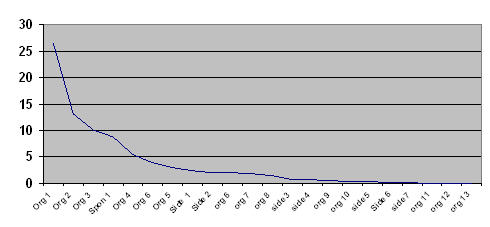 In 2006 Wired Editor Chris Anderson released The Long Tail, and suddenly we were finding long tails in everything. The swoop of the power law distribution curve was burned on our consciousness, and search was no exception. Suddenly, the hot new strategy was to move into the long tail of search, those thousands of key phrases that individually may only bring a handful of visitors, but in aggregate, can bring more than the head phrases. At Enquiro, we were no exception. But lately, I haven’t heard as much about long tail campaigns. And I think it’s because our thinking was a little flawed.
In 2006 Wired Editor Chris Anderson released The Long Tail, and suddenly we were finding long tails in everything. The swoop of the power law distribution curve was burned on our consciousness, and search was no exception. Suddenly, the hot new strategy was to move into the long tail of search, those thousands of key phrases that individually may only bring a handful of visitors, but in aggregate, can bring more than the head phrases. At Enquiro, we were no exception. But lately, I haven’t heard as much about long tail campaigns. And I think it’s because our thinking was a little flawed.
One of the key elements of a long tail marketplace is that there can’t be a scarcity bottleneck. Shelf space has to be unlimited, production, distribution, etc. The economics of supporting a long tail have to make sense. There has to be little to no overhead in making a vast selection available to the market. The ideal example is digital entertainment. Once an MP3 is encoded, the only overhead for the distributor is a couple of megabytes of storage capacity.
That’s just not true in search management. It takes time to set up a campaign for a keyword. It takes time to organically optimize for it. There’s significant campaign management overhead associated with search. From a resource perspective, search marketing is expensive, and as anyone who’s tried to recruit a search marketer can tell you, there is no abundance mentality at play here. Sure there’s thousands of keyphrases that may potentially bring one or two visitors a month, and if you add them up, it would be hundreds of thousands of potential leads, but we just can’t move from the head to the tail because we don’t have the time.
Engines tried to open up the bottle neck by offering broad match, but results from broad match campaigns are dramatically less than spectacular. In many cases, we needed to go back to the more granular control that comes with exact match to keep performance levels where we needed them to be.
But in perusing some of our spreadsheets from past studies, and with Anderson’s Long Tail curve fresh in my mind, I found another long tail in search. In several studies, we’ve tracked click throughs by position. Look what happens when you take the most popular click through position, the number one organic spot, and then work down by position:
As you can see, we have another long tail. Now, due to the scale of the graph, it looks like the tail goes to zero. This isn’t the case, but by the time we get to the second page of results, we tend to hit percentages that are fractions of 1%. As long tails go, this is skinnier than most, showing the power of position on the first page of results.
But now let’s combine the two long tails. If you take the head being a #1 organic ranking for your most popular phrase, and work down from there, the results get quite dramatic. For the sake of this example, I’ll move down one position for each keyword. Here’s a table showing the numbers:
| Keyword | Volume | Position | X Click Through % | Clicks |
| #1 | 46500 | Org 1 | 26.35 | 12252 |
| #2 | 38450 | Org 2 | 13.05 | 5017 |
| #3 | 32500 | Org 3 | 10.2 | 3315 |
| #4 | 23400 | Spon 1 | 8.75 | 2047 |
| #5 | 15750 | Org 4 | 5.35 | 842 |
| #6 | 12450 | Spon 2 | 4.125 | 513 |
| #7 | 8750 | Org 5 | 3.875 | 339 |
| #8 | 5250 | Org 6 | 2.875 | 150 |
| #9 | 4325 | Side 1 | 2.5 | 108 |
| #10 | 2750 | Org 7 | 1.875 | 51 |
Now, let’s plot that on a graph:
Given that search is a resource hog in terms of manpower, I argue that we’d be far better working our way up the tail rather than down it. And by moving up the tail, I mean the click through by position tail. By moving up the page, even a position or two, with relatively popular keywords, you can leverage the compounding effect of the two curves and dramatically improve your campaign performance.


